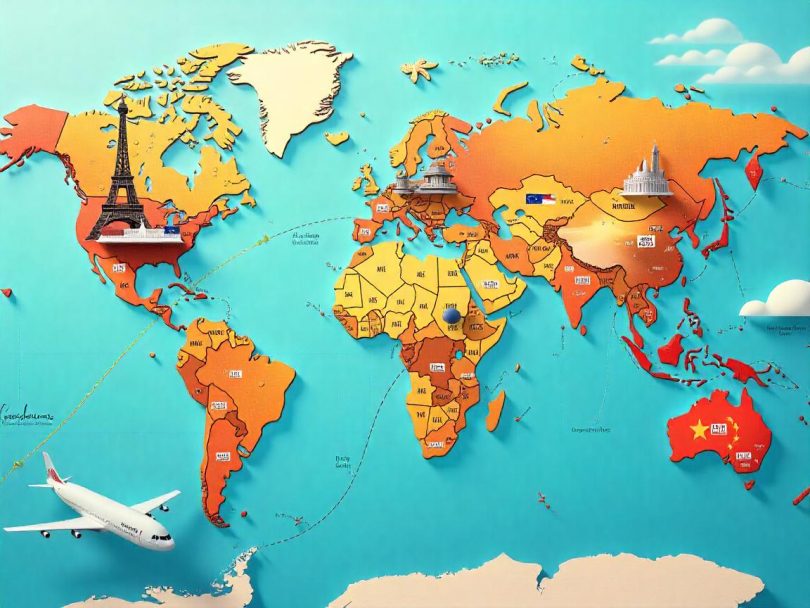Saturday, July 12, 2025
A storm is brewing in the world of travel, and its name is tariffs. Former President Donald Trump’s sweeping thirty percent duties on goods from Mexico and the European Union have ignited fresh fears of economic aftershocks that could bleed the U.S. tourism sector even further. While tariffs might sound like abstract policy, the impact is deeply human—and potentially devastating.
Airlines are bracing for pricier parts and supplies, hotels worry about skyrocketing costs for imported linens and luxury goods, and tour operators fear travelers might simply stay home. Destinations like Mexico, Italy, Spain, and even Canada are caught in the crossfire, unsure whether visitors will still come or seek cheaper, hassle-free alternatives.
As a new report uncovers the hidden truths behind these economic tremors, it’s clear that America’s travel industry stands at a precarious crossroads, facing yet another challenge in its fragile recovery journey.
An Introduction
US Travel is bracing for turbulence as Trump slaps thirty percent tariffs on the European Union and Mexico, sending shockwaves through airlines, hotels, and holiday plans worldwide. For airlines, higher costs loom over everything from aircraft parts to European wines served in premium cabins. Hotels worry about pricier imports that shape guest experiences, while tour operators fear travellers will abandon plans as costs soar.
Mexico, beloved for sunny escapes, risks losing its affordability edge as tariffs threaten goods from resort construction materials to local crafts. Across Europe, tourism boards scramble to calm fears of retaliatory tariffs, while fragile supply chains shiver under the strain. Meanwhile, travellers, already grappling with inflation, now fear price surges and trip cancellations. The stakes are enormous: a thriving tourism rebound teeters on the edge, facing the risk of vanishing under a new wave of political and economic uncertainty. One thing’s clear—global travel just entered a stormy new chapter.
A Trade War Becomes a Travel Crisis
The travel world is reeling as former US President Donald Trump launches a new front in his trade war, slapping 30% tariffs on imports from the European Union and Mexico. What sounds like an economic headline is fast becoming a travel crisis, poised to ripple through every airport, airline, hotel, and tour package that connects these major global markets.
Airlines, already strained by fuel price volatility, now face skyrocketing costs for aircraft parts, catering supplies, and even wine sourced from Europe. Hotel chains with heavy European footprints fear ballooning operational costs as imported fixtures, linens, and technology become drastically more expensive overnight. Tour operators see storm clouds gathering as travelers brace for higher package prices, cancellations, and shattered confidence.
Airlines Brace for Rising Costs
Meanwhile, the timing couldn’t be worse. Summer travel demand is surging, with Europe and Mexico among the top destinations for American travelers. But new tariffs threaten to turn this seasonal rebound into chaos. Airfares could spike as carriers adjust for new import costs on aircraft maintenance parts, onboard food and beverage sourced from European producers, and other essentials embedded in modern aviation.
Moreover, luxury travel faces a direct hit. From fine wines shipped from France to gourmet cheeses from Italy, products that fuel premium onboard services and luxury hotel experiences are squarely in the tariff crosshairs. For business-class and first-class travelers, prices could escalate as airlines attempt to protect margins while navigating turbulent economic skies.
Travelers Face Sticker Shock
For leisure travelers, the worry is palpable. Rising ticket prices and hotel rates risk derailing plans for European getaways or sunny escapes to Mexico. Families plotting long-awaited vacations may now rethink destinations entirely, while tour operators scramble to revise pricing and contracts for the remainder of 2025 and into 2026.
The numbers tell a stark story. The EU collectively exports more goods to the US than any other trading partner, exceeding $550 billion in 2022. A significant chunk of this flow fuels the travel ecosystem—from German-engineered aircraft parts to Belgian chocolates gracing luxury hotel turndown services.
Trump’s tariffs threaten to drive up prices on these goods, triggering inflationary pressure that could squeeze airlines, hotels, and tour companies. And when travel businesses pay more, so do travelers.
Mexico’s Travel Market Under Pressure
Meanwhile, Mexico’s tourism economy faces its own ticking clock. As one of America’s closest and most popular vacation markets, Mexico’s resorts and hospitality sector depend on steady flows of American visitors. Tariffs on goods moving across the border mean everything from construction materials for hotels to local artisan crafts could see price hikes, eroding Mexico’s competitive edge as an affordable paradise.
The psychological blow may be just as damaging as the economic one. Travelers, already navigating higher costs from global inflation, may fear further price shocks. Tour companies report rising anxiety among clients, asking whether future trips could suddenly cost hundreds or thousands more.
European Tourism on Edge
In global travel hubs like Frankfurt, Paris, and Cancun, tourism boards are hustling to reassure partners and travelers. Yet uncertainty reigns. Industry insiders warn that if Europe retaliates with tariffs of its own, the cost spiral could intensify. Air traffic agreements, aviation taxes, and tourism fees might all become bargaining chips in a widening economic standoff.
Moreover, supply chains remain fragile. Pandemic-era disruptions still linger, and adding tariffs compounds the risk of bottlenecks and delays for critical airline and hotel supplies. Even seemingly mundane goods—like the European-engineered espresso machines favored by boutique hotels—could become luxury items, sparking either higher rates for guests or cutbacks in premium services.
Travel Agencies Scramble for Solutions
For travel agencies, the operational headaches multiply. Dynamic pricing models rely on predictable costs to build profitable itineraries. With tariffs injecting new uncertainty, many agencies fear their carefully priced Europe or Mexico packages could become financial traps if import duties surge mid-season.
Meanwhile, corporate travel departments are crunching numbers. Business travelers heading to conferences, trade shows, or cross-border meetings could face higher airfare costs and hotel rates. Firms may cut back on trips, stifling recovery for business-focused airlines and convention centers alike.
Tourism-Dependent Destinations at Risk
The tourism ripple extends far beyond economics. Destinations like Italy, France, Spain, and Germany lean heavily on US visitors, who typically spend more per trip than travelers from other markets. A sudden slowdown from American tourists could impact local restaurants, guides, museums, and cultural sites, threatening jobs and local economies.
Mexico, similarly, faces a precarious balancing act. While Trump praised Mexico for helping control migration, he also blasted the country for failing to curb drug trafficking. These sharp political swings inject deep uncertainty into Mexico’s travel outlook. Hoteliers in Cancun and Los Cabos fear that volatility may drive American tourists to the Caribbean or domestic US resorts instead.
Trump’s Global Tariff Surge Threatens Travel: How Airlines, Hotels, and Destinations are Bracing for Impact
A New Trade Storm Hits Travel
Donald Trump’s fresh salvo of tariffs—slapping 30% duties on imports from the European Union and Mexico—has exploded far beyond trade policy. It’s sending shockwaves through the global travel industry, rattling airlines, hotels, tour operators, and millions of travelers planning their next getaway.
What might sound like purely economic headlines has turned into a full-blown tourism crisis. For destinations like Mexico, Canada, China, India, and key European nations such as Italy and Spain, the consequences could reshape the travel landscape for years to come.
Airlines Face a Perfect Storm of Rising Costs
The airline industry sits squarely in the crosshairs of this tariff storm. Modern aviation relies on complex international supply chains, and even the smallest cost increases ripple across the system. European-made aircraft components, high-quality catering products like French wines and cheeses, and maintenance supplies now face hefty surcharges.
These added costs threaten to push ticket prices higher, especially on transatlantic and cross-border routes where profit margins already run razor-thin. Carriers may be forced to cut capacity, raise fares, or scale back premium services.
Premium travelers accustomed to gourmet inflight meals and luxurious cabin amenities could see diminished service or steeper prices as airlines look for ways to offset costs. Budget travelers, too, might face rising base fares or extra charges that erode the affordability of international travel.
Mexican Tourism Teeters on a Knife’s Edge
Mexico, a top destination for American tourists, stands to lose significantly from Trump’s tariff barrage. The nation’s tourism economy depends not just on visitors but on affordable imports of goods used throughout the hospitality sector—from hotel furnishings to construction materials for resorts.
A 30% tariff instantly makes these imports more expensive, pushing up prices for new hotel builds or renovations. Mexican artisans, who produce handmade crafts that tourists love, also face increased costs for imported raw materials.
Travelers, meanwhile, may rethink vacations to Cancun, Los Cabos, or Riviera Maya if hotel rates and tour packages rise. Mexico has long been prized as an affordable luxury escape, but price hikes could push travelers toward the Caribbean, Florida, or even domestic trips within the U.S.
Tourism officials in Mexico are already launching local marketing efforts to reassure potential visitors and emphasize unique experiences that might offset higher costs. However, uncertainty remains high.
Canada’s Travel Boycott Drains US Tourism Dollars
Canada’s relationship with the U.S. has grown increasingly strained under repeated tariff threats. In recent months, a grassroots boycott movement has gained momentum among Canadians, fueled not only by tariffs but by broader political tensions.
Cross-border travel has plunged. Land crossings from Canada are down by nearly a quarter, and air travel bookings to U.S. cities have fallen dramatically. Entire sectors—like outlet malls, border casinos, and duty-free shops—are feeling the pinch as Canadian tourists stay home or choose European and Asian destinations instead.
For the U.S. tourism industry, this is no small matter. Canada remains America’s largest source of international visitors, accounting for billions in spending annually. If this boycott persists, it risks triggering deep economic wounds in border towns and major cities alike.
Europe Struggles With Tourism Uncertainty
Across Europe, tourism boards and travel businesses are scrambling to assess the fallout from Trump’s tariff wave. The European Union exports over $550 billion worth of goods to the United States annually, and many of those goods support the travel industry—whether directly or indirectly.
Italian luxury linens used in American hotel suites, Spanish wines served in high-end restaurants, German engineering in aviation components—all now face steep duties. Hotels and restaurants relying on imported European products must decide whether to absorb the costs or pass them on to guests.
The bigger risk is retaliation. European leaders have hinted at reciprocal tariffs, potentially sparking a broader trade war. In the meantime, uncertainty alone is enough to dampen travel enthusiasm. Bookings from European travelers to the U.S. have already slipped, as fears grow over higher costs, visa complexities, and political tensions.
China Turns Inward as Travel Drops
China was once one of the fastest-growing sources of tourists to the United States. However, trade hostilities have already chilled that relationship.
Before tariffs, Chinese travelers contributed billions annually to U.S. hotels, retail stores, and attractions. Now, a combination of new tariffs, geopolitical friction, and rising travel costs is steering Chinese tourists toward alternative destinations. Places like Australia, Southeast Asia, and domestic Chinese hotspots are capturing business that once flowed to American cities like Los Angeles, San Francisco, and New York.
For U.S. travel brands that invested heavily in attracting Chinese visitors, the shift is painful. Luxury retailers, in particular, miss the high-spending tourists who once arrived in droves, shopping for premium goods and booking VIP experiences.
India’s Outbound Market Faces Pressure
India, labeled a “tariff king” in earlier Trump rhetoric, finds itself navigating yet another challenge. U.S. tariffs threaten industries like pharmaceuticals, textiles, and gems—all sectors connected in some way to Indian tourism.
While fewer Indian travelers directly import goods, rising overall costs and an atmosphere of uncertainty can dampen travel demand. Middle-class Indians, who fueled a surge in outbound trips to the U.S. in recent years, may now opt for closer, more affordable destinations.
Indian tour operators worry about fluctuations in package costs and currency instability that could price American vacations out of reach for many. The result might be fewer bookings for U.S. tours, impacting airlines and attractions catering to Indian groups.
Vietnam Gains Quiet Momentum
Vietnam might not appear on every tourist’s radar as a direct alternative to the United States. Yet this Southeast Asian nation stands to benefit indirectly from the shifting global tides. As manufacturing flees China to avoid U.S. tariffs, Vietnam’s economy is booming, driving infrastructure improvements—including airports, resorts, and tourism services.
More disposable income among Vietnam’s growing middle class means increased domestic and regional travel. Additionally, tour operators are marketing Vietnam as an affordable, fascinating alternative to pricier Western destinations. The country’s mix of natural beauty, vibrant cities, and culinary delights makes it attractive for travelers looking to stretch their budgets without sacrificing quality experiences.
While Vietnam’s tourism gains are more subtle than Mexico’s or Europe’s, the country is strategically positioning itself for long-term growth fueled by the same global forces disrupting the U.S. market.
South Korea and Regional Shifts
South Korea is another quiet beneficiary in this geopolitical shuffle. While not directly targeted by Trump’s most aggressive tariff hikes, it stands to pick up regional travel business as tourists—especially from China—seek nearby destinations instead of long-haul U.S. trips.
Domestic tourism is also booming as South Koreans opt for closer holidays amid global uncertainties. Airlines and hotels have adapted quickly, offering attractive packages for regional travelers who might once have ventured further afield.
Economic modeling suggests South Korea’s accommodation and food service industries are seeing modest but steady growth tied to the turbulence in global trade. It’s a subtle shift but one that could solidify South Korea’s position as a regional tourism powerhouse in the years ahead.
Canada’s Travel Choices Shift Southward
Canada is experiencing a remarkable tourism realignment, driven largely by political tensions and the rise of tariff-induced costs. For decades, the United States was Canada’s top international travel destination. Now, many Canadians are choosing Mexico and Europe instead.
The reason is partly financial—tariffs threaten to raise the price of everything from hotel stays to restaurant meals in the United States. But it’s also emotional. A rising wave of Canadian travelers simply don’t want to support a country seen as imposing punitive trade policies.
This trend is no longer anecdotal. Land crossings from Canada into the U.S. have dropped sharply, and air bookings have declined by over 70% in some months. For American border towns and tourism businesses, this exodus spells significant economic pain. For destinations like Mexico and southern Europe, it’s pure opportunity.
US Tourism Faces Bleeding Wounds
Meanwhile, the U.S. tourism sector is bracing for further pain. The combination of higher costs, political uncertainty, and shifting traveler sentiment threatens to derail what should have been a strong recovery period after pandemic-era disruptions.
Travel Economics estimates U.S. inbound tourism could drop another 12-13% this year, translating into tens of billions in lost revenue. Luxury travel might suffer the most, as high-end hotels and airlines rely heavily on imported goods now subject to tariffs. But even mid-market and budget tourism isn’t immune, as general travel costs rise and travelers look for better value elsewhere.
The emotional damage is also significant. Travelers crave stability and predictability. When news headlines scream of new tariffs, retaliatory measures, and trade wars, many simply decide it’s safer—and more affordable—to stay closer to home or pick a country free from economic battles.
Destinations Must Adapt or Risk Losing Out
Across the tourism industry, the message is clear: adapt quickly or risk being left behind. Countries like Mexico and Spain are marketing themselves more aggressively, while airlines and tour operators pivot routes and packages to follow shifting demand.
Even in countries not directly affected by tariffs, there’s a growing recognition that traveler sentiment matters. People want not only affordability but the feeling that their vacation dollars are supporting places welcoming and stable.
The next 12 months will be critical. The global tourism map is being redrawn in real time. For some destinations, it’s a chance to win new business. For others, it’s a high-stakes battle for survival.
A World Rewritten by Tariffs
Trump’s tariffs were never only about steel, cars, or trade deficits. They’ve triggered a domino effect reshaping where travelers go, how much they pay, and how destinations position themselves. Countries like Mexico, Spain, and Vietnam are emerging as unexpected winners, riding waves of shifting traveler loyalty and economic opportunity.
Meanwhile, the U.S. tourism sector faces a harsh reality: political decisions made far from hotel lobbies and airport gates have the power to change its future.
As the dust settles, one truth remains clear. Travel has always been more than movement—it’s a mirror reflecting the world’s shifting alliances, tensions, and dreams. And right now, that mirror reveals a tourism landscape more fragile, and more fascinating, than ever before.
Hotel Industry Feels the Squeeze
Hotels across the U.S. are bracing for a squeeze. High-end properties often source European linens, Italian furniture, German appliances, and gourmet goods that elevate guest experiences. A sudden 30% price hike on these items could force hoteliers to either raise room rates or compromise on quality.
Mid-tier and budget hotels also face challenges. Construction materials from Mexico and Europe could become significantly more expensive, delaying renovations or new builds. Guests might notice older rooms and fewer modern amenities as properties tighten budgets to absorb new costs.
Moreover, the uncertainty makes it harder for hotel chains to plan investments. Many are adopting a wait-and-see approach, delaying projects until the tariff situation becomes clearer.
Tour Operators Pivot Strategies
Tour operators are some of the first to feel the consequences of tariffs. Package prices depend on stable costs for flights, hotels, and activities. New tariffs create price volatility that could erode profit margins or force uncomfortable price hikes.
Operators specializing in U.S. tours for European, Mexican, or Chinese clients report growing hesitation among customers. Many travelers are worried about future surcharges, changing visa policies, or sudden political tensions that could disrupt trips.
To protect their businesses, tour operators are pivoting to promote destinations unaffected by new tariffs. Countries in South America, Southeast Asia, and even domestic tourism in Europe or China are seeing increased marketing efforts.
The Emotional Toll on Travelers
Beyond economic data lies an equally real emotional impact. Many travelers, still recovering from pandemic-era uncertainty, crave stability. Headlines about new trade wars, rising costs, and political fights reignite anxiety. People worry their dream vacations might suddenly become unaffordable or complicated by new rules.
For millions of would-be tourists, the joy of travel now comes with added fear. Will prices skyrocket just weeks before departure? Will destinations retaliate with their own rules, making travel harder? These questions weigh heavily on consumers considering where to spend their hard-earned money and precious vacation days.
A Fragile Future for Global Tourism
One thing is clear: the global tourism industry is entering a period of turbulence. Trump’s tariffs are more than trade measures—they’re shockwaves disrupting the delicate threads connecting nations through travel, culture, and commerce.
Airlines, hotels, tour operators, and entire destinations must adapt quickly to an environment where costs are rising and politics drive unpredictability. The stakes are immense. Billions in revenue hang in the balance, and travelers everywhere are left questioning where—and how—they’ll explore the world next.
Travel Dreams Hang in the Balance
Beyond economic data, the emotional toll is real. Many travelers, after years of pandemic lockdowns, crave connection and new experiences. Now, headlines of new tariffs revive memories of trade wars, border tensions, and political fights that once choked travel demand. The fear of sudden costs and unstable policies looms large.
Yet the industry is nothing if not resilient. Airlines are already lobbying Washington for tariff relief on aviation-related imports. Hotel chains are renegotiating contracts, seeking local suppliers to reduce tariff exposure. Tour operators are pivoting marketing efforts, promoting destinations unaffected by new duties to keep bookings alive.
But make no mistake—the stakes are high. Trump’s latest tariff salvo could either stall the fragile recovery or permanently reshape global travel patterns.
Travelers, businesses, and entire economies now watch anxiously, waiting to see if trade negotiations can avert further chaos. For the global tourism industry, the coming months could be decisive—a time when the joy of travel hangs in the balance between policy decisions and economic realities.
One thing is certain: the journey just became far more complicated for everyone.











